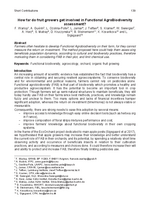How far do fruit growers get involved in Functional AgroBiodiversity assessment?
Warlop F., Guérin A., Ozolina-Polle L., Jamar L., Telfser J., Kramer S., Swiergiel W., Herz A., Matray S., Kruczynska D., Steinemann B., Kovarikova K., Sigsgaard L. (2018). How far do fruit growers get involved in Functional AgroBiodiversity assessment? Proceedings of the 18th International Conference on Organic Fruit-Growing 2018, 139-143.Farmers often hesitate to develop Functional Agrobiodiversity on their farm, for they cannot
measure the return on investment. The method proposed here could help them asses-sing
beneficials population dynamics, according to cultural and biodiversity practices, therefore
motivating them in considering FAB in their plot, and limit chemical use.
Documents

|
How far do fruit growers get involved in Functional AgroBiodiversity assessment? () Warlop F., Guérin A., Ozolina-Polle L., Jamar L., Telfser J., Kramer S., Swiergiel W., Herz A., Matray S., Kruczynska D., Steinemann B., Kovarikova K., Sigsgaard L. (2018). How far do fruit growers get involved in Functional AgroBiodiversity assessment? Proceedings of the 18th International Conference on Organic Fruit-Growing 2018, 139-143. |
Links
|
Ecofruit-Proceedings of the 18th International Conference on Organic Fruit-Growing 2018 “Ecofruit” is the continuation of the 17 previous meetings. It aims to bring together European researchers and consultants working on topics related to organic fruit growing. “Ecofruit” gives an opportunity to communicate and discuss latest results connected with organic fruit growing with regard to the improvement of the production system. |
Details
- Activity type
- Publication in scientific journal (peer review)
- Activity work package
- Reduction in pesticide residues
- Activity number
- Laimburg - WP3 - A96
- Activity contact
- Dr. Markus Kelderer
Laimburg Research Centre
Laimburg 6 - Pfatten
I-39040 Post Auer (BZ), Italy
[email protected] - Activity partner
- Laimburg
- Activity country
- Italy
- Last edit
- 23-11-2018

The EUFRUIT thematic network has received funding from the
European Union's Horizon 2020 research and innovation programme
under grant agreement No 696337.
European Union's Horizon 2020 research and innovation programme
under grant agreement No 696337.